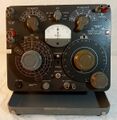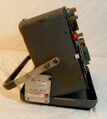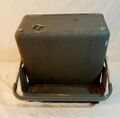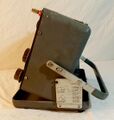1650-A: Difference between revisions
Jump to navigation
Jump to search
No edit summary |
No edit summary |
||
| (2 intermediate revisions by the same user not shown) | |||
| Line 3: | Line 3: | ||
|codes=BATON,1650-9701,1650-9540,1650-9570 | |codes=BATON,1650-9701,1650-9540,1650-9570 | ||
|class=impedance measurement | |class=impedance measurement | ||
|summary= | |summary=Portable impedance bridge | ||
|image=Gr 1650-a 1.jpeg | |image=Gr 1650-a 1.jpeg | ||
|caption=Genrad 1650-A Bridge | |caption=Genrad 1650-A Bridge | ||
| Line 19: | Line 19: | ||
The 1650 was the first GR impedance bridge to feature the "Orthonull" function, which is a mechanical link driving the DQ dial from the CRL dial through a friction clutch. (Conversely, turning the DQ dial will ''not'' turn the CRL dial.) | The 1650 was the first GR impedance bridge to feature the "Orthonull" function, which is a mechanical link driving the DQ dial from the CRL dial through a friction clutch. (Conversely, turning the DQ dial will ''not'' turn the CRL dial.) | ||
It helps avoid the "sliding null" problem when measuring components with high losses. | It helps avoid the "sliding null" problem when measuring components with high losses. | ||
The [[1650-P1|1650-P1 Test Jig]] accessory was designed for the 1650-A. | |||
==Key Specifications== | ==Key Specifications== | ||
| Line 58: | Line 60: | ||
===Internal=== | ===Internal=== | ||
<gallery> | <gallery> | ||
GR 1650-A internal 1.jpg | GR 1650-A internal 1.jpg | Internal view. The red jack on the bottom left is an aftermarket modification on this unit for an external +6 V supply. | ||
GR 1650-A internal 2.jpg | GR 1650-A internal 2.jpg | ||
GR 1650-A internal 3.jpg | GR 1650-A internal 3.jpg | ||
Latest revision as of 17:35, 4 June 2024
The General Radio 1650-A is a portable impedance bridge introduced in Catalog P (1959). It was succeeded by the 1650-B in Catalog T (1968).
The 1650 was the first GR impedance bridge to feature the "Orthonull" function, which is a mechanical link driving the DQ dial from the CRL dial through a friction clutch. (Conversely, turning the DQ dial will not turn the CRL dial.) It helps avoid the "sliding null" problem when measuring components with high losses.
The 1650-P1 Test Jig accessory was designed for the 1650-A.
Key Specifications
- Capacitance: 1 pF to 1100 μF in 7 ranges
- Inductance: 1 μH to 1100 H in 7 ranges
- Resistance: 1 mΩ to 11 MΩ in 8 ranges, AC or DC
- D (of series capacitance): 0.001 to 1 at 1 kHz, (parallel capacitance) 0.1 to 50 at 1 kHz
- Q (of series inductance): 0.02 to 10 at 1 kHz, (parallel inductance) 1 to 1000 at 1 kHz
- Basic accuracy: ±1% of full scale, ±5% for dissipation factor
- Internal oscillator: 1 kHz ±2%
- Frequency range: 20 Hz to 20 kHz (to 100 kHz with reduced accuracy)
- DC Supply: 6 V, max. 60 mA; Battery: Four D cells, current drain 10 mA (AC measurements)
- External Oscillator and Detector: Type 1210-C Unit R-C Oscillator, Type 1311-A Audio Oscillator and Type 1232-A Tuned Amplifier and Null Detector are recommended for audio measurements at frequencies other than 1 kHz
- DC Polarization: 600 V may be applied (from external source) for series capacitance measurements
- Weight: 17 pounds (8 kg) net
Links
- The GR 1650-A & 1650-B Portable Bridges @ conradhoffman.com
- US Patent 2872639, Henry P Hall, Electrical bridge and method. Filed Oct. 10, 1956; Granted Feb. 3, 1959 (describing the Orthonull feature)
- US Patent 2966257, Henry C Littlejohn, Instrument carrying case. Filed Nov. 5, 1959; Granted Dec. 27, 1960
- Henry P. Hall, A New Universal Impedance Bridge. General Radio Experimenter Volume 33, No. 3, March 1959, page 3.
- Henry P. Hall, Orthonull - A Mechanical Device to Improve Bridge Balance Convergence. General Radio Experimenter Volume 33, No. 4, April 1959, page 7.
- IET Labs Application Note, Henry Hall: Father of the Digibridge
Videos
- General Radio Genrad 1650 impedance bridge - Oscillator Circuit repair and calibration @ YouTube
- General Radio 1650-A Experimentation with Coils Capacitors and Tank circuits @ YouTube
- Vacuum Tube Audio Transformer Impedance Determined With General Radio Impedance Bridge @ YouTube
Pictures
Internal
-
Internal view. The red jack on the bottom left is an aftermarket modification on this unit for an external +6 V supply.
-
-
-
-
-
-
-













